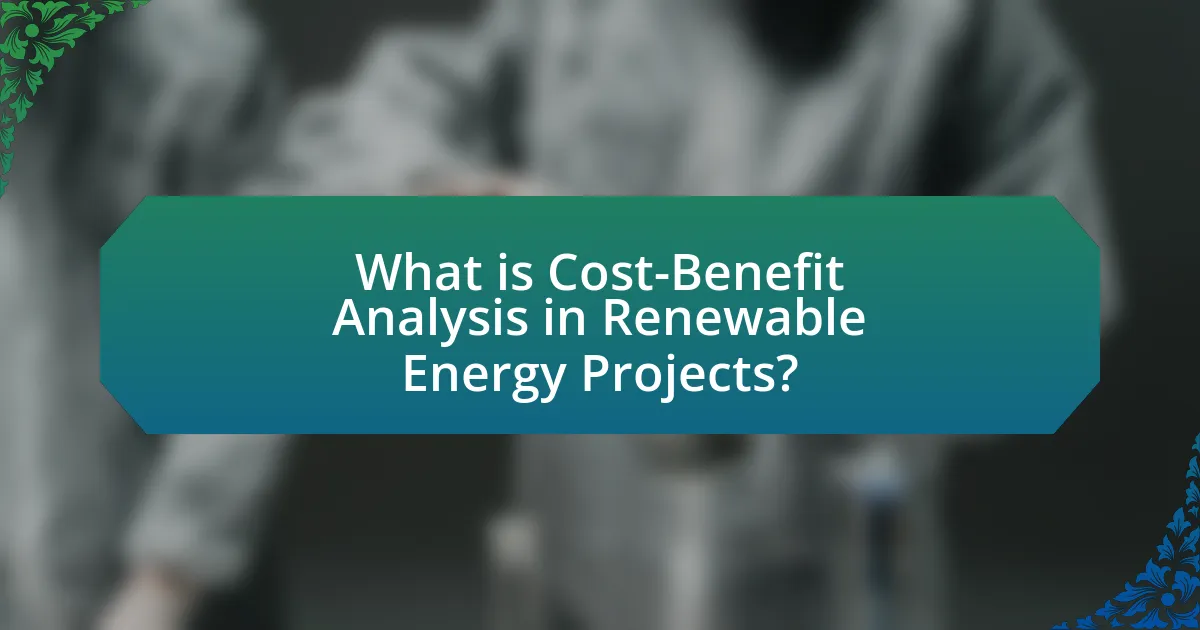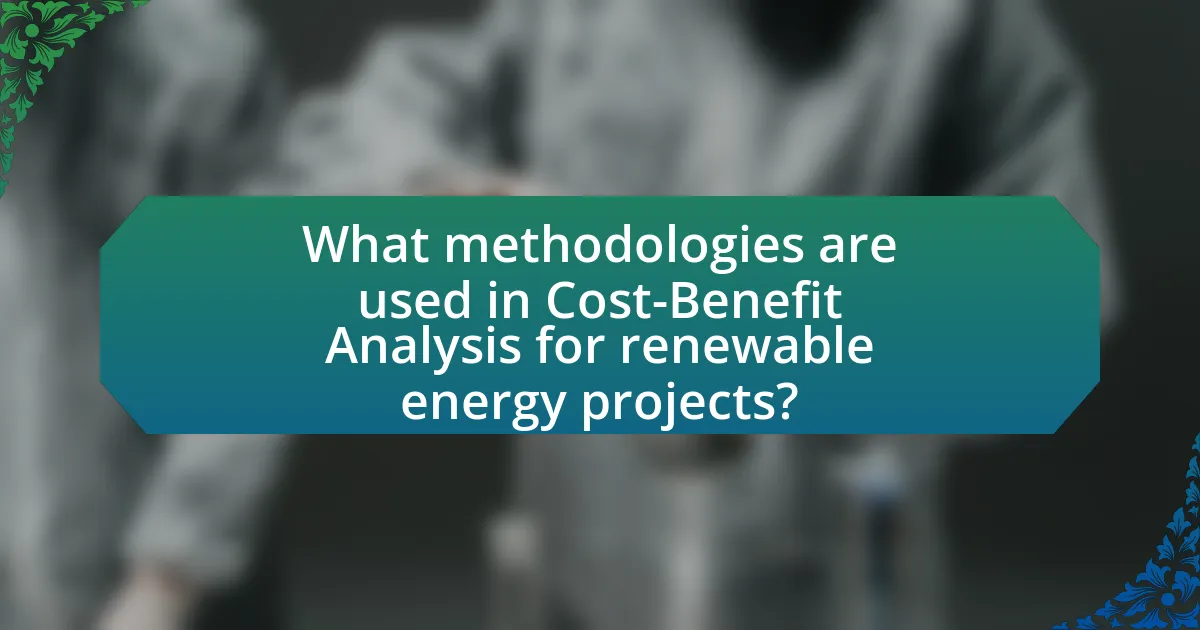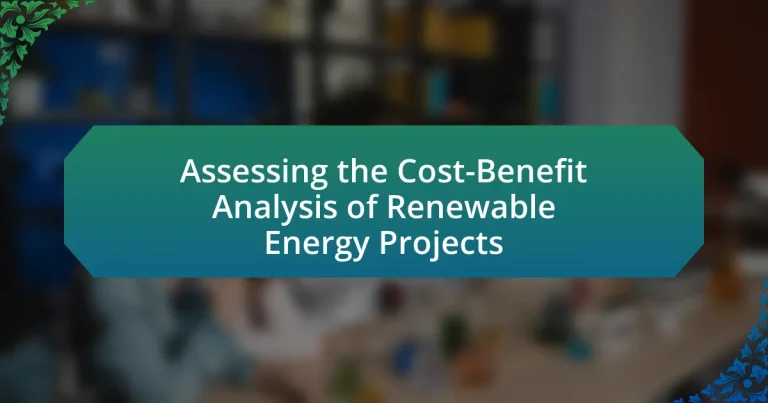Cost-Benefit Analysis (CBA) is a critical tool for evaluating the economic feasibility of renewable energy projects by systematically comparing expected costs and benefits. This article outlines the definition of CBA in the context of renewable energy, its key components, and its importance in project decision-making and stakeholder engagement. It also discusses common challenges in conducting CBA, the data required for accurate analysis, and methodologies used in the evaluation process. Additionally, the article highlights the significance of environmental and social benefits, best practices for conducting CBA, and the practical implications for stakeholders involved in renewable energy investments.

What is Cost-Benefit Analysis in Renewable Energy Projects?
Cost-Benefit Analysis (CBA) in renewable energy projects is a systematic approach to evaluating the economic feasibility of such initiatives by comparing the expected costs and benefits. This analysis quantifies both tangible and intangible factors, including initial investment, operational costs, environmental impacts, and social benefits, to determine the overall value of the project. For instance, a study by the National Renewable Energy Laboratory found that the benefits of solar energy projects often outweigh their costs by a factor of 3 to 1, highlighting the financial viability and positive impact of renewable energy investments.
How is Cost-Benefit Analysis defined in the context of renewable energy?
Cost-Benefit Analysis (CBA) in the context of renewable energy is defined as a systematic approach to evaluating the economic feasibility of renewable energy projects by comparing the expected costs and benefits associated with them. This analysis quantifies both direct and indirect impacts, such as installation costs, maintenance expenses, environmental benefits, and social implications, to determine the overall value of the project. For instance, a study by the National Renewable Energy Laboratory found that the benefits of solar energy projects often outweigh their costs by a factor of three to one, demonstrating the effectiveness of CBA in guiding investment decisions in renewable energy.
What are the key components of a Cost-Benefit Analysis?
The key components of a Cost-Benefit Analysis (CBA) include identifying costs and benefits, quantifying them in monetary terms, discounting future values, and conducting sensitivity analysis. Identifying costs involves recognizing all expenses associated with a project, such as initial investment, operational costs, and maintenance. Benefits encompass all positive outcomes, including revenue generation, environmental impact, and social benefits. Quantifying these elements in monetary terms allows for a direct comparison, while discounting future values accounts for the time value of money, ensuring that future costs and benefits are appropriately valued. Sensitivity analysis tests how changes in assumptions affect outcomes, providing insight into the robustness of the analysis. These components collectively enable decision-makers to evaluate the feasibility and desirability of renewable energy projects effectively.
How does Cost-Benefit Analysis differ from other evaluation methods?
Cost-Benefit Analysis (CBA) differs from other evaluation methods by quantifying both the costs and benefits of a project in monetary terms, allowing for a direct comparison. Unlike qualitative methods, which may focus on subjective assessments or non-monetary factors, CBA provides a clear numerical framework that facilitates decision-making based on economic efficiency. For instance, CBA can assign a dollar value to environmental benefits, such as reduced emissions, which other methods may overlook or assess qualitatively. This quantification enables stakeholders to evaluate the net economic impact of renewable energy projects, making CBA a preferred tool for policymakers and investors seeking to maximize resource allocation.
Why is Cost-Benefit Analysis important for renewable energy projects?
Cost-Benefit Analysis (CBA) is crucial for renewable energy projects because it systematically evaluates the economic viability and potential impacts of these initiatives. CBA helps stakeholders quantify the benefits, such as reduced greenhouse gas emissions and energy savings, against the costs, including initial investments and operational expenses. For instance, a study by the National Renewable Energy Laboratory found that every dollar invested in renewable energy can yield up to four dollars in economic benefits, demonstrating the financial advantages of these projects. By providing a clear framework for decision-making, CBA ensures that resources are allocated efficiently, maximizing the positive outcomes of renewable energy investments.
What role does it play in project decision-making?
Cost-benefit analysis plays a critical role in project decision-making for renewable energy projects by providing a systematic approach to evaluate the economic feasibility and potential impacts of the project. This analytical tool quantifies the expected costs and benefits, allowing decision-makers to compare alternatives and assess the overall value of the project. For instance, a study by the National Renewable Energy Laboratory found that comprehensive cost-benefit analyses can lead to more informed investment decisions, ultimately enhancing project viability and sustainability.
How does it influence stakeholder engagement?
The cost-benefit analysis of renewable energy projects significantly influences stakeholder engagement by providing a clear framework for evaluating the economic viability and environmental impact of these initiatives. This analysis allows stakeholders, including investors, community members, and policymakers, to understand the potential returns and risks associated with the projects. For instance, a study by the National Renewable Energy Laboratory found that transparent cost-benefit assessments can enhance trust and collaboration among stakeholders, leading to increased support for renewable energy initiatives. By quantifying benefits such as job creation and reduced emissions alongside costs, stakeholders are better equipped to make informed decisions, fostering a more engaged and proactive community around renewable energy projects.
What are the common challenges in conducting Cost-Benefit Analysis for renewable energy projects?
Common challenges in conducting Cost-Benefit Analysis (CBA) for renewable energy projects include uncertainty in future energy prices, difficulties in quantifying environmental benefits, and the long time horizons associated with these projects. Uncertainty in future energy prices can lead to inaccurate projections of costs and benefits, complicating the analysis. Additionally, quantifying environmental benefits, such as reductions in greenhouse gas emissions, often involves subjective estimates and assumptions, which can introduce bias. The long time horizons of renewable energy projects, which can span decades, make it challenging to account for changes in technology, policy, and market conditions, further complicating the CBA process.
What data is typically required for accurate analysis?
Accurate analysis of renewable energy projects typically requires data on project costs, energy production estimates, operational and maintenance expenses, and environmental impacts. Specifically, project costs include initial capital investment, financing costs, and decommissioning expenses. Energy production estimates are derived from historical data, resource availability, and technology performance metrics. Operational and maintenance expenses encompass ongoing costs associated with running the project, while environmental impacts involve assessments of emissions reductions and ecological effects. This data is essential for creating reliable cost-benefit analyses that inform decision-making in renewable energy investments.
How can uncertainty affect the outcomes of the analysis?
Uncertainty can significantly impact the outcomes of the analysis by introducing variability in the estimated costs and benefits of renewable energy projects. This variability can lead to inaccurate projections, which may result in suboptimal decision-making. For instance, a study by the National Renewable Energy Laboratory found that uncertainty in future energy prices can alter the net present value of renewable energy investments by up to 30%. Such fluctuations can mislead stakeholders regarding the viability and attractiveness of these projects, ultimately affecting investment decisions and policy formulation.

What are the key factors influencing Cost-Benefit Analysis outcomes?
The key factors influencing Cost-Benefit Analysis (CBA) outcomes include the accuracy of cost estimates, the reliability of benefit projections, the time frame of analysis, and the discount rate applied. Accurate cost estimates ensure that all expenses related to a project are accounted for, while reliable benefit projections help in assessing the true value generated by the project. The time frame of analysis affects the perceived value of future benefits, and the discount rate determines how future costs and benefits are valued in present terms. For instance, a study by Boardman et al. (2018) emphasizes that variations in discount rates can significantly alter the CBA results, impacting decision-making in renewable energy projects.
How do initial investment costs impact the analysis?
Initial investment costs significantly influence the cost-benefit analysis of renewable energy projects by determining the project’s financial viability and return on investment. High initial costs can lead to longer payback periods, which may deter investors and stakeholders from supporting the project. For instance, a study by the International Renewable Energy Agency (IRENA) in 2020 indicated that projects with lower upfront costs tend to achieve quicker financial returns, making them more attractive to investors. Additionally, the initial investment affects the overall cost structure, impacting operational and maintenance costs over the project’s lifespan. Therefore, accurately assessing initial investment costs is crucial for a comprehensive analysis of the project’s economic feasibility and long-term sustainability.
What are the typical costs associated with renewable energy projects?
The typical costs associated with renewable energy projects include capital expenditures, operational and maintenance costs, and financing costs. Capital expenditures often account for the largest portion, with solar photovoltaic systems averaging between $1,000 to $3,000 per installed kilowatt, while wind energy projects can range from $1,200 to $5,000 per installed kilowatt. Operational and maintenance costs generally range from 1% to 3% of the initial investment annually. Financing costs can vary significantly based on interest rates and project scale, impacting the overall financial viability of these projects. According to the International Renewable Energy Agency (IRENA), the global weighted-average cost of electricity from solar photovoltaics fell by 89% between 2009 and 2020, demonstrating a trend of decreasing costs in renewable energy technologies.
How can financing options alter the cost structure?
Financing options can significantly alter the cost structure of renewable energy projects by affecting both initial capital costs and ongoing operational expenses. For instance, utilizing debt financing can lower upfront costs through loans, allowing projects to spread payments over time, which can enhance cash flow management. Additionally, equity financing can reduce the burden of interest payments, thereby decreasing overall financial risk. According to a report by the International Renewable Energy Agency (IRENA), projects financed through favorable loans or grants can achieve a cost reduction of up to 30% compared to those relying solely on traditional financing methods. This demonstrates that the choice of financing directly influences the economic viability and sustainability of renewable energy initiatives.
What role do operational and maintenance costs play?
Operational and maintenance costs are critical in determining the overall financial viability of renewable energy projects. These costs directly impact the net present value and return on investment calculations, influencing decision-making for stakeholders. For instance, a study by the National Renewable Energy Laboratory found that operational and maintenance costs can account for 20-30% of the total lifecycle costs of wind and solar projects, underscoring their significance in cost-benefit analyses. By accurately estimating these costs, project developers can better assess the long-term sustainability and profitability of renewable energy investments.
How do these costs vary across different renewable energy technologies?
Costs vary significantly across different renewable energy technologies, with solar photovoltaic (PV) systems generally having lower installation costs compared to offshore wind and concentrated solar power (CSP). For instance, as of 2023, the levelized cost of electricity (LCOE) for utility-scale solar PV is approximately $30 to $60 per megawatt-hour, while offshore wind ranges from $60 to $120 per megawatt-hour, and CSP can exceed $100 per megawatt-hour. These variations are influenced by factors such as technology maturity, resource availability, and capital investment requirements. For example, solar PV has benefited from rapid technological advancements and economies of scale, leading to a significant reduction in costs over the past decade, while offshore wind projects often involve higher logistical and infrastructure expenses.
What strategies can be employed to minimize these costs?
To minimize costs in renewable energy projects, strategies such as optimizing project design, leveraging economies of scale, and utilizing advanced technologies can be employed. Optimizing project design involves careful planning and site selection to reduce material and labor costs, which can significantly impact overall expenses. Leveraging economies of scale means increasing the size of projects to lower the cost per unit of energy produced; for instance, larger solar farms often benefit from reduced installation and operational costs. Utilizing advanced technologies, such as energy storage systems and smart grid solutions, enhances efficiency and reduces long-term operational costs. These strategies are supported by studies indicating that optimized designs can reduce costs by up to 20%, and economies of scale can lead to a 30% decrease in per-unit costs for larger installations.
How do environmental and social benefits factor into the analysis?
Environmental and social benefits are integral to the analysis of renewable energy projects as they contribute to the overall assessment of project viability and impact. These benefits include reductions in greenhouse gas emissions, improved public health outcomes, and enhanced community resilience. For instance, a study by the National Renewable Energy Laboratory found that transitioning to renewable energy sources can lead to a significant decrease in air pollution, which is linked to lower healthcare costs and improved quality of life. Additionally, social benefits such as job creation in the renewable sector and increased energy security further enhance the positive outcomes of these projects. Thus, incorporating environmental and social benefits into the cost-benefit analysis provides a more comprehensive understanding of the true value and impact of renewable energy initiatives.
What are the common environmental benefits associated with renewable energy?
Renewable energy offers significant environmental benefits, primarily by reducing greenhouse gas emissions. For instance, transitioning from fossil fuels to renewable sources like solar and wind can decrease carbon dioxide emissions by up to 80% in the electricity sector, as reported by the International Renewable Energy Agency. Additionally, renewable energy reduces air pollutants, leading to improved air quality and public health outcomes. According to the U.S. Environmental Protection Agency, the shift to renewable energy could prevent thousands of premature deaths annually due to air pollution. Furthermore, renewable energy sources contribute to biodiversity preservation by minimizing habitat destruction associated with fossil fuel extraction and use. Overall, these benefits underscore the positive impact of renewable energy on the environment.
How can social impacts be quantified in the analysis?
Social impacts can be quantified in the analysis by employing various metrics such as surveys, social return on investment (SROI), and community engagement assessments. Surveys can gather data on community perceptions and changes in quality of life, while SROI calculates the social value generated relative to the investment made, providing a monetary value to social benefits. Community engagement assessments evaluate the level of stakeholder involvement and satisfaction, which can be quantified through participation rates and feedback scores. These methods allow for a structured approach to measuring social impacts, ensuring that they are integrated into the overall cost-benefit analysis of renewable energy projects.

What methodologies are used in Cost-Benefit Analysis for renewable energy projects?
Cost-Benefit Analysis (CBA) for renewable energy projects employs several methodologies, including quantitative analysis, qualitative assessment, and multi-criteria analysis. Quantitative analysis involves calculating the net present value (NPV) and internal rate of return (IRR) to evaluate financial viability. Qualitative assessment focuses on non-monetary factors such as environmental impact and social acceptance. Multi-criteria analysis integrates various indicators, allowing stakeholders to weigh different aspects of the project. These methodologies ensure a comprehensive evaluation of both economic and non-economic factors, facilitating informed decision-making in renewable energy investments.
What are the standard methodologies for conducting Cost-Benefit Analysis?
The standard methodologies for conducting Cost-Benefit Analysis (CBA) include the identification of costs and benefits, quantification of these elements, discounting future values, and sensitivity analysis. First, identifying costs and benefits involves listing all relevant economic, social, and environmental impacts associated with a project. Next, quantification requires assigning monetary values to these identified costs and benefits, often using market prices or shadow pricing when market prices are unavailable. Discounting future values is essential to account for the time value of money, typically using a discount rate that reflects opportunity costs. Finally, sensitivity analysis tests how changes in key assumptions affect the CBA results, ensuring robustness in decision-making. These methodologies are widely recognized in economic evaluations, as outlined in the guidelines from the U.S. Office of Management and Budget and the European Commission’s impact assessment guidelines.
How does the Discounted Cash Flow method work?
The Discounted Cash Flow (DCF) method works by estimating the value of an investment based on its expected future cash flows, which are adjusted for the time value of money. This method involves projecting the cash flows that the investment will generate over a specific period and then discounting those cash flows back to their present value using a discount rate, typically reflecting the risk of the investment and the opportunity cost of capital.
For example, if a renewable energy project is expected to generate $100,000 annually for the next five years, and the discount rate is set at 10%, the present value of those cash flows would be calculated to determine the project’s worth today. This approach is widely used in financial analysis to assess the viability and profitability of projects, particularly in the renewable energy sector, where future cash flows can be uncertain but significant.
What is the role of sensitivity analysis in the methodology?
Sensitivity analysis plays a crucial role in the methodology of assessing the cost-benefit analysis of renewable energy projects by evaluating how changes in input variables affect the outcomes of the analysis. This process helps identify which variables have the most significant impact on project viability, allowing decision-makers to understand the risks and uncertainties involved. For instance, sensitivity analysis can reveal how fluctuations in energy prices, capital costs, or operational expenses influence the net present value of a project. By systematically altering these variables, stakeholders can prioritize areas for further investigation and develop strategies to mitigate potential risks, thereby enhancing the robustness of the cost-benefit analysis.
How can qualitative factors be integrated into the analysis?
Qualitative factors can be integrated into the analysis of renewable energy projects by employing structured frameworks that assess non-monetary benefits and impacts. These frameworks, such as the Multi-Criteria Decision Analysis (MCDA), allow for the systematic evaluation of qualitative aspects like social acceptance, environmental sustainability, and community impact alongside quantitative data. For instance, a study by M. A. H. D. Rahman et al. in “Renewable and Sustainable Energy Reviews” (2020) highlights how stakeholder engagement and public perception can significantly influence project outcomes, demonstrating that qualitative factors are essential for a comprehensive cost-benefit analysis.
What are some examples of qualitative benefits in renewable energy projects?
Qualitative benefits in renewable energy projects include improved public health, enhanced energy security, and increased community engagement. Improved public health arises from reduced air pollution and greenhouse gas emissions, which lead to fewer respiratory diseases and related health issues. Enhanced energy security is achieved through diversification of energy sources, reducing dependence on fossil fuels and mitigating risks associated with energy supply disruptions. Increased community engagement occurs as local stakeholders participate in project planning and implementation, fostering a sense of ownership and promoting social cohesion. These benefits contribute to the overall sustainability and acceptance of renewable energy initiatives.
How can stakeholder perspectives be incorporated into the analysis?
Stakeholder perspectives can be incorporated into the analysis by conducting structured interviews, surveys, and focus groups to gather their insights and opinions. This approach ensures that diverse viewpoints are represented, which enhances the comprehensiveness of the cost-benefit analysis. For instance, a study by the International Renewable Energy Agency (IRENA) highlights that engaging stakeholders leads to more accurate assessments of social and environmental impacts, ultimately improving project outcomes. By systematically integrating stakeholder feedback, analysts can better align renewable energy projects with community needs and expectations, thereby increasing acceptance and support.
What best practices should be followed when conducting Cost-Benefit Analysis?
When conducting Cost-Benefit Analysis (CBA), best practices include clearly defining the scope of the analysis, identifying all relevant costs and benefits, and using a consistent time frame for evaluation. Clearly defining the scope ensures that all stakeholders understand the objectives and limitations of the analysis. Identifying all relevant costs and benefits, including direct, indirect, and intangible factors, provides a comprehensive view of the project’s impact. Using a consistent time frame allows for accurate comparison of costs and benefits over time, facilitating better decision-making. Additionally, sensitivity analysis should be performed to assess how changes in assumptions affect outcomes, enhancing the robustness of the analysis. These practices are supported by guidelines from organizations such as the U.S. Office of Management and Budget, which emphasizes thoroughness and transparency in CBA.
How can transparency be ensured in the analysis process?
Transparency in the analysis process can be ensured by implementing standardized methodologies and openly sharing data sources and assumptions. Standardized methodologies, such as those outlined by the Intergovernmental Panel on Climate Change (IPCC), provide a consistent framework for evaluating renewable energy projects, which enhances comparability and credibility. Additionally, openly sharing data sources and assumptions allows stakeholders to verify the analysis, fostering trust and accountability. For instance, the U.S. Department of Energy emphasizes the importance of transparency in its guidelines for conducting cost-benefit analyses, which include detailed documentation of inputs and processes. This approach not only clarifies the rationale behind decisions but also enables independent review and scrutiny, ultimately leading to more robust and reliable outcomes in renewable energy project assessments.
What are the common pitfalls to avoid in Cost-Benefit Analysis?
Common pitfalls to avoid in Cost-Benefit Analysis include overlooking indirect costs, failing to account for non-monetary benefits, and using inappropriate discount rates. Overlooking indirect costs can lead to an incomplete assessment of a project’s financial implications, as these costs may significantly impact overall viability. Failing to account for non-monetary benefits, such as environmental improvements or social equity, can result in undervaluing a project’s true worth. Using inappropriate discount rates can distort the present value of future benefits and costs, leading to misguided investment decisions. These pitfalls can compromise the accuracy and reliability of the analysis, ultimately affecting decision-making in renewable energy projects.
What are the practical implications of Cost-Benefit Analysis for stakeholders in renewable energy projects?
Cost-Benefit Analysis (CBA) provides stakeholders in renewable energy projects with a systematic approach to evaluate the economic viability and potential impacts of their investments. By quantifying both the costs and benefits associated with a project, stakeholders can make informed decisions that align with financial, environmental, and social objectives. For instance, a study by the National Renewable Energy Laboratory found that for every dollar invested in renewable energy, there is an average return of $2.50 in economic benefits, highlighting the financial incentives for stakeholders. Additionally, CBA helps identify trade-offs and prioritize projects that yield the highest net benefits, ensuring efficient allocation of resources and enhancing stakeholder engagement through transparent decision-making processes.




